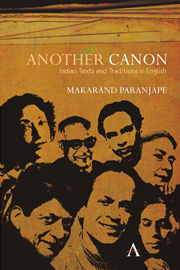Book contents
- Frontmatter
- Contents
- Preface
- 1 Introduction
- 2 Conversations in Bloomsbury
- 3 Comrade Kirillov
- 4 ‘A Horse and Two Goats’
- 5 The Tale of an Indian Education
- 6 ‘Clip Joint’
- 7 Cultural and Political Allegory in Rich Like Us
- 8 Towards Redefining Boundaries
- 9 The Golden Gate and the Quest for Self-Realization
- 10 Journey to Ithaca An Epistle on the Fiction of the 1980s and 1990s
- 11 Cuckold in Indian English Fiction
- 12 Stephanians and Others
- Works Cited
- Index
1 - Introduction
Situating the Contemporary Indian (English) Novel
Published online by Cambridge University Press: 05 March 2012
- Frontmatter
- Contents
- Preface
- 1 Introduction
- 2 Conversations in Bloomsbury
- 3 Comrade Kirillov
- 4 ‘A Horse and Two Goats’
- 5 The Tale of an Indian Education
- 6 ‘Clip Joint’
- 7 Cultural and Political Allegory in Rich Like Us
- 8 Towards Redefining Boundaries
- 9 The Golden Gate and the Quest for Self-Realization
- 10 Journey to Ithaca An Epistle on the Fiction of the 1980s and 1990s
- 11 Cuckold in Indian English Fiction
- 12 Stephanians and Others
- Works Cited
- Index
Summary
The task of situating the contemporary Indian English novel will necessarily be a tentative rather than a normative one, marked perhaps by the sputtering, flickering, even involuntary exertions of the illocutionary subject. In fact, when I first wrote this Introduction. I remember starting off by admitting that it had been crosshatched between two contrary discursive impulses, or should I say, compulsions – on the one hand, the cordial and insistent invitation to embark upon such an exercise and on the other hand, my own inner reluctance to undertake the kind of ‘fixing’ that the word situating implies. On further reflection, I think that the contrary impulses were deeper and had to do with the nature of the project of situating the Indian novel itself rather than merely the tussle between having to write and needing to remain silent, vocalizing and reflecting, going out and staying at home.
The word ‘situate’, itself has an interesting etymology. It may not be out of place to mention here that the tendency to use etymology to clarify what we mean should not be alien to us in India because our learned ancestors often resorted to Nirukta to establish meanings in Vedic exegesis. Thus, the recourse to etymology and derivations is not alien to our hermeneutic traditions. As an aside, we may bear in mind that Nirukta and etymology are not the same.
- Type
- Chapter
- Information
- Another CanonIndian Texts and Traditions in English, pp. 1 - 12Publisher: Anthem PressPrint publication year: 2009



